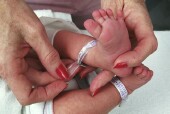- Skip Storing This Everyday Product in the Fridge Door
- Green Tea + B3 Pairing May Boost Brain Health
- Navigating Your Midlife Crisis: Embracing New Possibilities
- City Raccoons Showing Signs of Domestication
- Mapping the Exposome: Science Broadens Focus to Environmental Disease Triggers
- One Week Less on Social Media Linked to Better Mental Health
- Your Brain Changes in Stages as You Age, Study Finds
- Some Suicide Victims Show No Typical Warning Signs, Study Finds
- ByHeart Formula Faces Lawsuits After Babies Sickened With Botulism
- Switch to Vegan Diet Could Cut Your Greenhouse Gas Emissions in Half
Researchers Describe 1st ‘Functional Cure’ of HIV in Baby


SUNDAY, March 3A baby born two-and-a-half years ago in Mississippi with HIV is the first case of a so-called “functional cure” of the infection, researchers announced Sunday.
Standard tests can no longer detect any traces of the AIDS-causing virus even though the child has discontinued HIV medication.
“We believe this is the first well-documented case of a [functional] cure,” said study lead author Dr. Deborah Persaud, associate professor of pediatrics in the division of infectious diseases at Johns Hopkins Children’s Center in Baltimore. The finding was presented Sunday at the Conference on Retroviruses and Opportunistic Infections, in Atlanta.
The child was not part of a study but, instead, the beneficiary of an unexpected and partly unplanned sequence of events that — once confirmed and replicated in a formal study — might help more children who are born with HIV or who at risk of contracting HIV from their mother eradicate the virus from their body.
Normally, mothers infected with HIV take antiretroviral drugs that can almost eliminate the odds of the virus being transferred to the baby.
If a mother doesn’t know her HIV status or hasn’t been treated for other reasons, the baby is given “prophylactic” drugs at birth while awaiting the results of tests to determine his or her HIV status. This can take four to six weeks to complete. If the tests are positive, the baby starts HIV drug treatment.
The mother of the baby born in Mississippi didn’t know she was HIV-positive until the time of delivery.
But in this case, both the initial and confirmatory tests on the baby were able to be completed within one day, allowing the baby to be started on HIV drug treatment within the first 30 hours of life.
“Most of our kids don’t get picked up that early,” Persaud explained.
As expected, the baby’s “viral load” — detectable levels of HIV — decreased progressively until it was no longer detectable at 29 days of age.
Theoretically, this child (doctors aren’t disclosing the gender) would have taken the medications for the rest of his or her life, said the researchers, who included doctors from the University of Massachusetts Medical School and the University of Mississippi Medical Center.
Instead, the child stayed on the regimen for only 18 months before dropping out of the medical system and discontinuing the drugs.
Ten months after stopping treatment, however, the child was again seen by doctors who were surprised to find no HIV virus or HIV antibodies with standard tests.
Ultrasensitive tests did detect infinitesimal traces of viral DNA and RNA in the blood. But the virus was not replicating — a highly unusual occurrence given that drugs were no longer being administered, the researchers said.
No one is absolutely sure why this child achieved a “functional” cure — meaning the virus is in remission even without medications. But investigators believe that giving antiviral treatment so early in life meant the virus had no time to create viral “reservoirs” where dormant HIV cells can linger for years before becoming active again.
“For us this is a very exciting finding,” said Persaud. “By treating a baby very early [we may be able to] prevent viral reservoirs or cells that stay around for a lifetime of an infected person.”
But Dr. Michael Horberg, chair of the HIV Medicine Association and director of HIV/AIDS at Kaiser Permanente, stressed that this was a “functional cure and not a cure in the most classic sense of the word.”
“If we take adults off HIV medications, they almost certainly within a short time period would have levels of virus back to where they were before they were taking medication,” he said.
Only one instance of a “sterilizing cure” — when there are absolutely no traces of HIV in the body — has been documented. This occurred in the so-called “Berlin patient,” an American man living in Germany who received a bone marrow transplant for leukemia. The transplanted cells came from a donor who had a rare genetic mutation that increases immunity against the most common form of HIV. This patient has remained HIV-free after discontinuing drug therapy.
And Persaud said she is not advocating that the Mississippi case become the standard of care. “This is a single case and we don’t really know what are all of the factors [involved],” she said.
But the case does “pave the way now for us to immediately start clinical studies to see if we can replicate these findings in more infants,” Persaud said. Those trials are ready to move forward.
At the last follow-up, the child born in Mississippi was “doing well and was healthy,” she added.
Horberg said the findings in the baby were “encouraging” but “time will tell” if such a strategy can keep the virus under control for long periods of time without medication.
He emphasized that there are ways to prevent a baby from becoming infected in the first place.
“This again shows the importance of testing pregnant mothers and getting them into care and on [drug] treatment such that we wouldn’t even need to worry about it at this point,” he said. “What’s encouraging, though, if it does come to this point, we might have some good treatment options.”
The research presented Sunday was funded by the U.S. National Institutes of Health and the American Foundation for AIDS Research
More information
Learn more about mother-to-child transmission of HIV at aids.gov.
Source: HealthDay
Copyright © 2025 HealthDay. All rights reserved.










